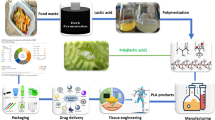Abstract
Biodegradable polyesters are established biomaterials in medicine due to their chemical characteristics and options for material processing. A main problem, however, is the release of acid degradation products during biodegradation with severe local pH-drops and inflammatory reactions. Polyesteramides, in contrast, show a less prominent pH-drop during degradation. In this study, we developed a simple, reproducible synthesis of the poly(ester amide) (PEA) type C starting from ε-caprolactame, 1,4-butanediol, and adipic acid in a one-batch two-step reaction and conducted the manufacturing of PEA-derived 3D textile scaffolds applicable for tissue engineering purposes. The thermal and mechanical properties of PEA-type C were analysed and the structural conformity of different batches was confirmed by NMR spectroscopy and size exclusion chromatography. The polymer was formed into nonwovens by textile manufacturing. Cytotoxicity tests and X-ray photoelectron spectroscopy (XPS) were used to analyze the effect of scaffold extraction before cell seeding. The manufactured carriers were seeded with human preadipocytes and examined for cellular proliferation and differentiation. The production of PEA type C successfully occurred via simultaneous ring-opening polymerization of ε-caprolactame and polycondensation with 1,4-butanediol and adipic acid at 250 °C under high-vacuum. Soxhlet extraction allowed optimal cleaning of nonwoven scaffolds. Extracted PEA-derived matrices were capable of allowing good adherence, proliferation, and differentiation of preadipocytes. These results are encouraging and guidance towards an optimally prepared nonwoven carrier applicable for clinical use.







Similar content being viewed by others
References
S. J. HUANG, in “Polymers - Biomaterials and Medical Application”, Edited by: J. I. KROSCHWITZ (Wiley & Sons, New York, 1989) p. 286
H. KISE, M. KOBAYASHI and Y. FAN, J. Polym. Sci. 39 (2001) 1318
P. A. GUNATILLAKE and R. ADHIKARI, ECM 5 (2003) 1
M. S. TAYLER, A. U. DANIELS, K. P. ANDRIANO and J. HELLER, J. Appl. Biomater. 5 (1994) 151
C. S. RANUCCI and P. V. MOGHE, Tissue Eng. 5 (1999) 407
M. X. LI, R. X. ZHUO and F. Q. QU, J. Polym. Sci. Part A: Polym Chem. 40 (2002) 4550
M. VERA, A. ADMETLLA, A. RODRIGUEZ-GALÁN and A. PUIGGALÍ, Polym. Degrad. Stab. 89 (2005) 21
H. L. GUAN, C. DENG, X. Y. XU, Q. Z. LIANG, X. S. CHEN and X. B. JING, J. Polym. Sci. Part A: Polym Chem. 43 (2005) 1144
H. KEUL and H. HÖCKER, Macromol. Rapid. Commun. 21 (2000) 869
H. KEUL, B. ROBERTZ and H. HÖCKER, Macromol. Symp. 144 (1999) 47
P. A. ZUK, M. ZHU, P. ASHJIAN, D. A. DE UGARTE, J. I. HUANG, H. MIZUNO, et al., Mol. Biol. Cell. 13 (2002) 4279
P. A. ZUK, M. ZHU, H. MIZUNO, J. HUANG, J. W. FUTRELL, A. J. KATZ, et al., Tissue Eng. 7 (2001) 211
A. MIRANVILLE, C. HEESCHEN, C. SENGENÈS, C. A. CURAT, R. BUSSE and A. BOULOUMIE, Circulation 110 (2004) 349
H. HAUNER, K. ROHRIG and T. PETRUSCHKE, Eur. J. Clin. Invest. 25 (1995) 90
P. A. GUNATILLAKE and R. ADHIKARI, Eur. Cells Mater. 5 (2003) 1
L. J. SUGGS and A. G. MIKOS, in “Physical Properties of Polymers Handbook”, Vol. 96 (AIP Press, Woodbury, 1996) p. 625
Y. IKADA and H. TSUJI, Macromol. Rapid. Commun. 21 (2000) 117
D. KLEE, Z. ADEMOVIC, A. BOSSERHOFF, H. HOECKER, G. MAZIOLIS and H. J. ERLI, Biomaterials 24 (2003) 3663
Y. JIAO, X. MA, S. YU and M. SHAO, Hua Xi Kou Qiang Yi Xue Za. Zhi. 18 (2000) 75
R. M. WYRE and S. DOWNES, Biomaterials 23 (2002) 357
K. HEMMRICH, D. VON HEIMBURG, K. CIERPKA, S. HAYDARLIOGLU and N. PALLUA, Differentiation 73 (2005) 28
Acknowledgements
This research work is part of a project funded by the “HOLSTE-Stiftung” of the RWTH Aachen University. Additionally, the Federal Ministry of Economics and Labour (BMWA = Bundesministerium für Wirtschaft und Arbeit) and its partner organisation the German Federation of Industrial Research Associations “Otto von Guericke” (Arbeitsgemeinschaft industrieller Forschungsvereinigungen “Otto von Guericke” e.V.) are gratefully thanked for financial support of the research project (AiF-No. 107 ZN/1). The authors are also grateful to the DECHEMA (Society for Chemical Engineering and Biotechnology) for cooperation.
Author information
Authors and Affiliations
Corresponding author
Additional information
K. Hemmrich and J. Salber have contributed equally.
Rights and permissions
About this article
Cite this article
Hemmrich, K., Salber, J., Meersch, M. et al. Three-dimensional nonwoven scaffolds from a novel biodegradable poly(ester amide) for tissue engineering applications. J Mater Sci: Mater Med 19, 257–267 (2008). https://doi.org/10.1007/s10856-006-0048-3
Received:
Accepted:
Published:
Issue Date:
DOI: https://doi.org/10.1007/s10856-006-0048-3




